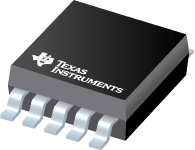Packaging information
| Package | Pins VSSOP (DGS) | 10 |
| Operating temperature range (°C) -40 to 125 |
| Package qty | Carrier 250 | SMALL T&R |
Features for the INA238
- High-resolution, 16-bit delta-sigma ADC
- Current monitoring accuracy:
- Offset voltage: ±5 µV (maximum)
- Offset drift: ±0.02 µV/°C (maximum)
- Gain error: ±0.1% (maximum)
- Gain error drift: ±25 ppm/°C (maximum)
- Common mode rejection: 140 dB (minimum)
- Power monitoring accuracy:
- 0.7% full scale, –40°C to +125°C (maximum)
- Fast alert response: 75 µs
- Wide common-mode range: –0.3 V to +85 V
- Bus voltage sense input: 0 V to 85 V
- Shunt full-scale differential range: ±163.84 mV / ±40.96 mV
- Input bias current: 2.5 nA (maximum)
- Temperature sensor: ±1°C (maximum at 25°C)
- Programmable conversion time and averaging
- 2.94-MHz high-speed I2C interface with 16 pin-selectable addresses
- Operates from a 2.7-V to 5.5-V
supply:
- Operational current: 640 µA (typical)
- Shutdown current: 5 µA (maximum)
Description for the INA238
The INA238 is an ultra-precise digital power monitor with a 16-bit delta-sigma ADC specifically designed for current-sensing applications. The device can measure a full-scale differential input of ±163.84 mV or ±40.96 mV across a resistive shunt sense element with common-mode voltage support from –0.3 V to +85 V.
The INA238 reports current, bus voltage, temperature, and power, all while performing the needed calculations in the background. The integrated temperature sensor is ±1°C accurate for die temperature measurement and is useful in monitoring the system ambient temperature.
The low offset and gain drift design of the INA238 allows the device to be used in precise systems that do not undergo multi-temperature calibration during manufacturing. Further, the very low offset voltage and noise allow for use in A to kA sensing applications and provide a wide dynamic range without significant power dissipation losses on the sensing shunt element. The low input bias current of the device permits the use of larger current-sense resistors, thus providing accurate current measurements in the micro-amp range.
The device allows for selectable ADC conversion times from 50 µs to 4.12 ms as well as sample averaging from 1x to 1024x, which further helps reduce the noise of the measured data.
